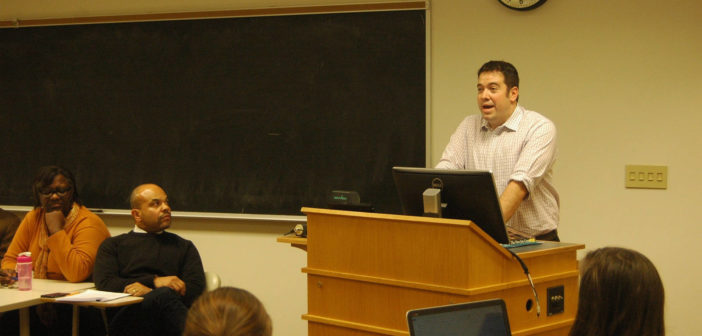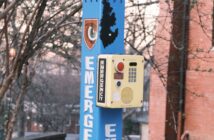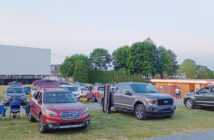Telling fact from fiction has become an increasingly difficult task with the rise of social media and self-publishing.
Along with the disapproval of journalists from the leader of our nation, Americans’ trust in the media has dropped, and the concept of “fake news” continues to make headlines.
President Donald Trump’s criticism of the liberal media as “fake news” continues to be a hot topic of conversation, which takes over his Twitter account. On Feb. 24, the White House press secretary banned journalists from The New York Times, CNN and Politico from attending Trump’s daily briefing. That night, Trump tweeted, “FAKE NEWS media knowingly doesn’t tell the truth. A great danger to our country. The failing @nytimes has become a joke. Likewise @CNN. Sad!”
Before discussing fake news, Anthony DiMaggio, an assistant professor of political science, said it is important to define it. DiMaggio said fake news is any sort of news content containing manipulated information.
Kathy Olson, an associate professor of journalism, does not believe the term “fake news” is useful because it has so many definitions. Fake news is associated with stories that are false — “clickbait” — and stories the current administration doesn’t like, making the term rather ambiguous, she said.
DiMaggio said Trump is creating a lose-lose situation as well as attempting to distract the nation from more important policy related issues.
“The biggest problem is one that’s intended, which is to create enough uncertainty and doubt about anything being said such that the only reliable source is the candidate you believe in,” said Saladin Ambar, an associate professor of political science.
Olson said a problem with inaccurate news stories is that our democracy depends on the press to gain factual information about who will be running the government. If the public is provided with incorrect information, there is the possibility it could make a choice it might not make knowing the facts.
Fake news stories can also be perpetuated by those in power. DiMaggio said up to 90 percent of all political news story sources are political leaders.
“Journalists aren’t conveying their own bias, but when most of their information is given by people in power, (political leaders) can easily convey their bias,” DiMaggio said.
Corporate news outlets, for example, sensor media that attacks donors, DiMaggio said.
The professors believe educators need to do a better job of teaching their students media literacy skills, not only at the collegiate level, but in K-12 as well.
“One way to protect yourself is to vet the sources of the things you view,” Olson said.
She added that readers can vet sources by looking at who’s providing the article, such as a large newspaper or a small blog with a political agenda. Readers can also check to see if multiple media outlets are providing the same information. If only one outlet is covering a story, it’s probably not true.
DiMaggio said he once found a fake article that appeared to be written by the BBC, but upon closer inspection he realized the URL had ‘.ca’ instead of ‘.com.’ He said paying attention to small details like this can help readers discern reliable and unreliable sources.
DiMaggio said readers should also be aware of what type of piece they are reading. Some people will claim op-eds are fake news when they are opinion pieces, not news stories.
Olson said fake news is covered under the first amendment, which cannot ban or punish it, however any media that contains slander or libel is not. Olson said the government should not oversee vetting, as that would be censorship. She believes it is solely on the individual to consume information critically.
Olson said it would be incredibly problematic if social media sites, like Facebook, created a panel to sift through what it would deem fake news.
Ambar said it is on the individual to be a well-informed, active citizen.
“It’d be well advised to (use) history as a framework of which past practices might help us understand the present better,” Ambar said. “We don’t want to turn into Germany circa 1934 with only state television.”
DiMaggio said while it is on the people to be more skeptical of what they are reading and become more politically involved, he would support a taxpayer-funded, non-partisan group of fact checkers. Their role wouldn’t be to dictate what media outlets can and can’t produce, but to inform outlets that their information might not be entirely factual.






Comment policy
Comments posted to The Brown and White website are reviewed by a moderator before being approved. Incendiary speech or harassing language, including comments targeted at individuals, may be deemed unacceptable and not published. Spam and other soliciting will also be declined.
The Brown and White also reserves the right to not publish entirely anonymous comments.
2 Comments
perhaps it would be appropriate to mention Senator Frank Church and the 1975 Church Committee hearings and ‘operation mockingbird’. Seems William Colby had much to say about the relationship between the media and the intel community, ie, Langley.
http://www.carlbernstein.com/magazine_cia_and_media.php
I equate the President’s media bashing to jury tampering and witness harassment. Discredit the source of inconvenient facts, to mislead and misdirect. I’m reminded of a former Fox News reporter who was told not to report the facts, but to muddy the waters, so facts were manipulated in accordance to corporate views.
The professors are correct to say we must filter our sources carefully.